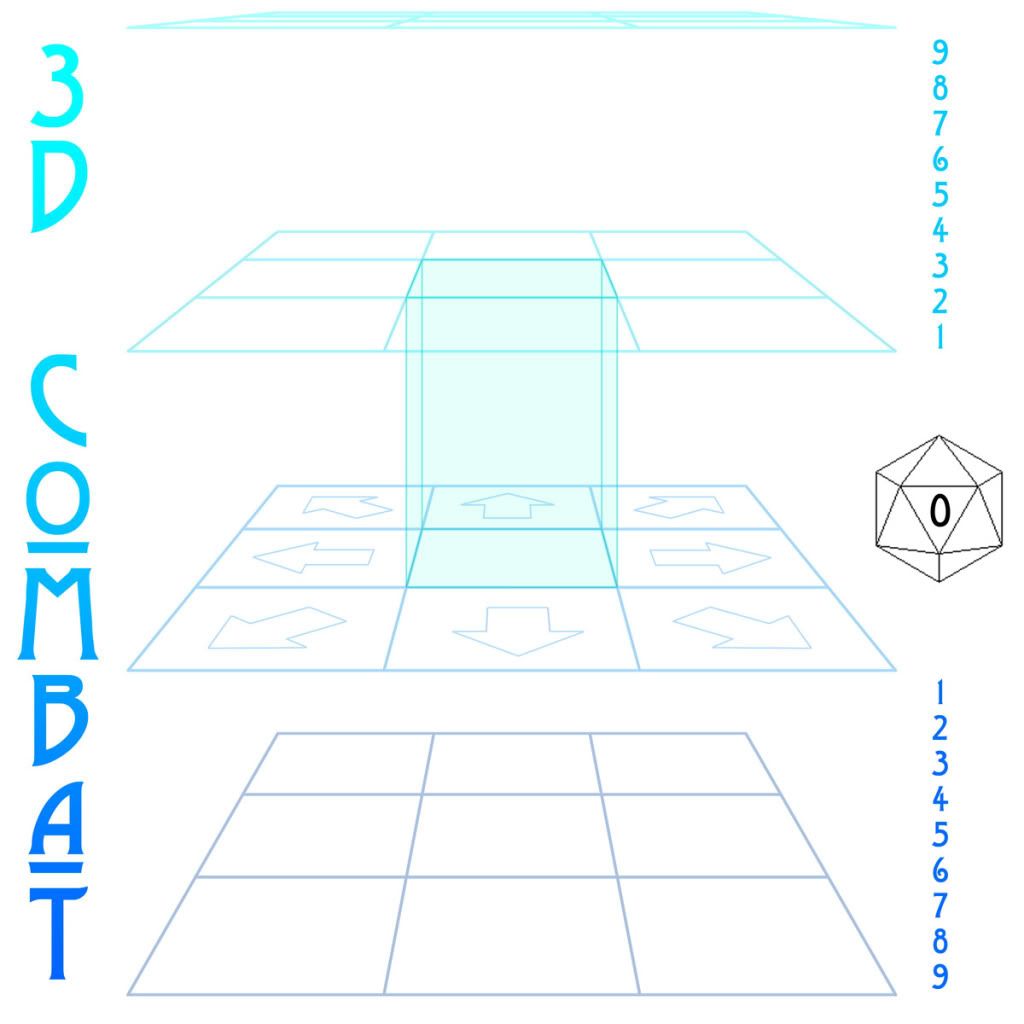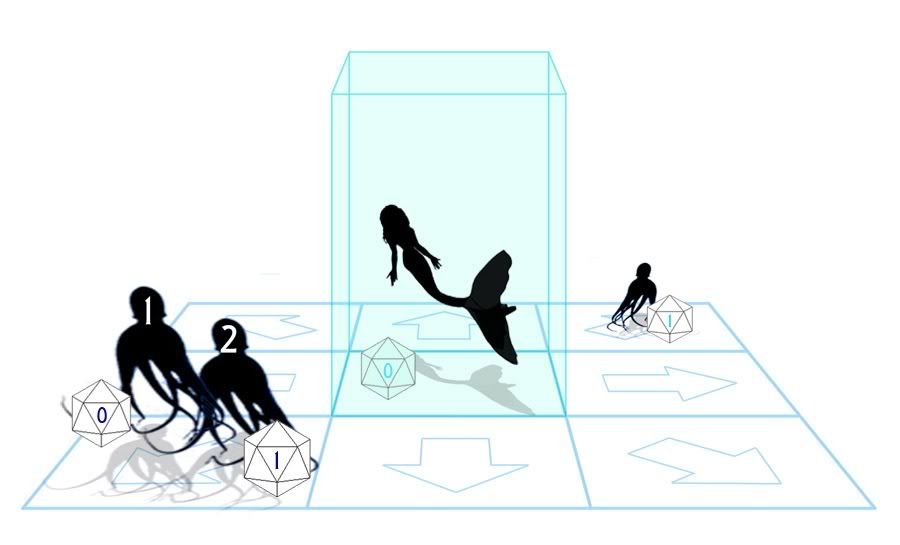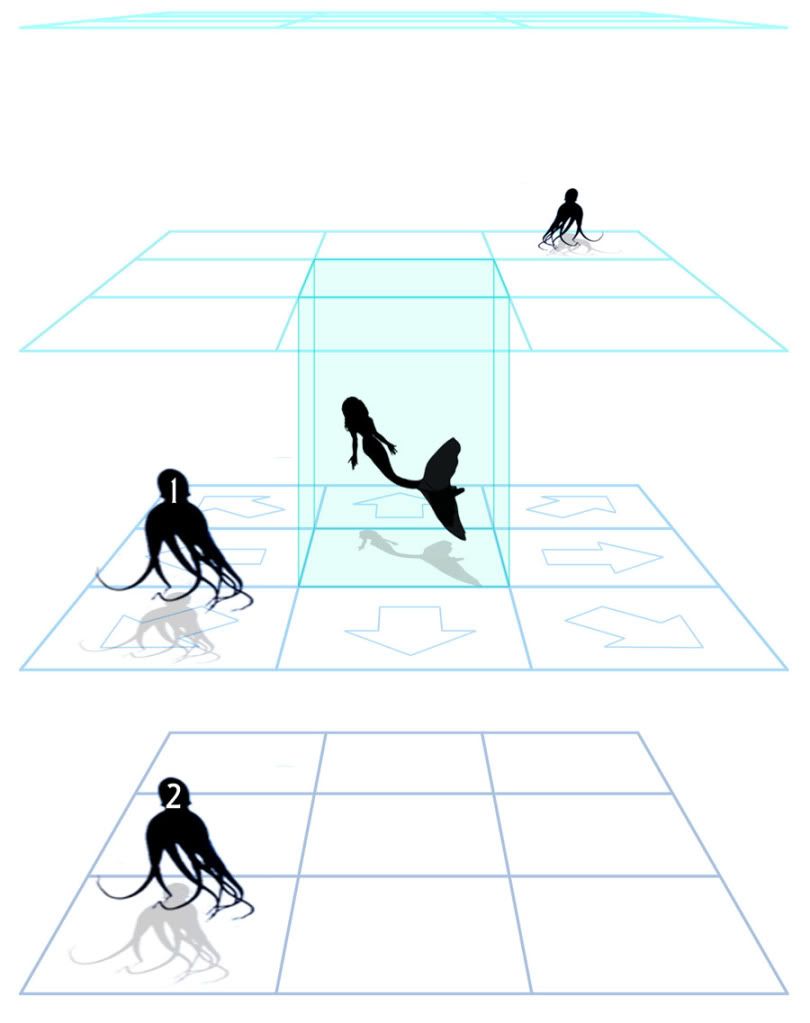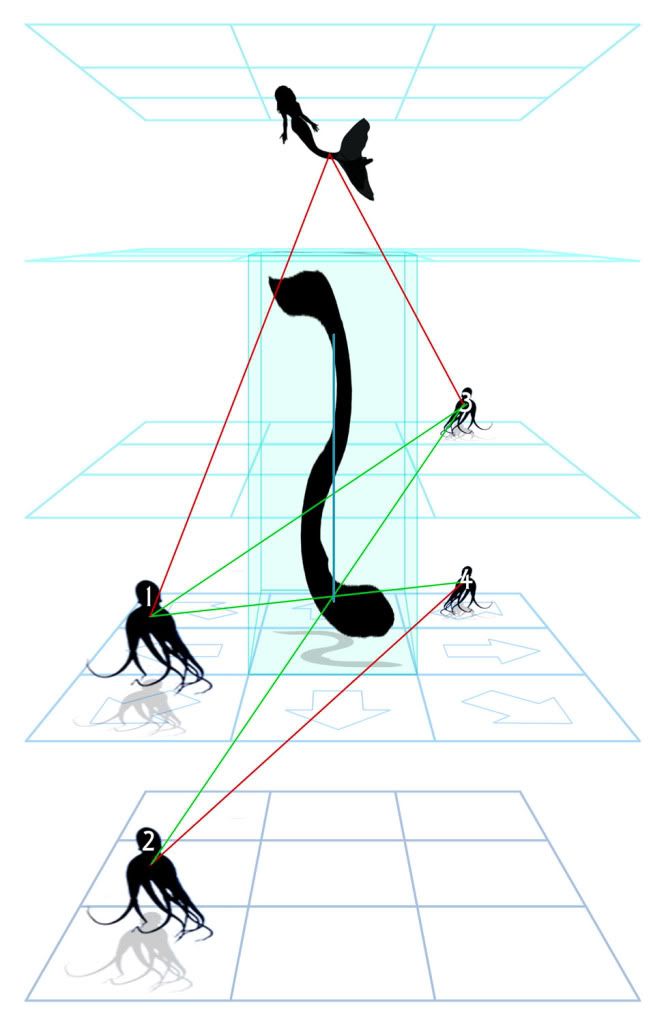Physics
Danger From All Sides
Despite the tranquil vista of oceans of the Endless Blue setting, Elqua is a very dangerous place to simply live. Without solid boundaries to prevent the encroachment of other creatures, every cubic inch of the seas can hide a quick death in the jaws of a predator or by the passive defenses of prey. To eat or be eaten is the basic law of nature, and on Elqua it is as true as anywhere. Eventually, inevitably, sooner or later everything has to fight for its life.
The depth that combat takes place uses the table-top as an anchor point, just as if you were playing a game in any other setting. However, being surrounded in other games only means having eight opponents ringed around you. In the Endless Blue campaign setting, where a character’s buoyancy keeps him floating at a controllable depth in the water, becoming surrounded means twenty-six opponents boxing a victim in from all directions – eight around, nine above, and nine below. With that many possible combatants, keeping track of three dimensional position on a two dimensional plane becomes problematic.

To address this, each model will need a special die. At first glace it would appear to be a twenty-sided die, closer inspection of the faces reveals two sequences of 0-9 in two colors. In the case of the examples here, the two colors are light blue and dark blue. Each face signifies how many “cubes” (the 3D equivalent to D20’s “squares”) above or below the table-top the creature floats. The lighter blue numbers represent altitudes higher than the models on the table-top, and darker blue means lower depths. Each cube roughly equals 5 cubic feet of space. This means a die set to 2 is approximately 10 feet above the table top, and 5 means twenty-five feet below the table-top. When a creature moves, simply add (for ascending upward) or subtract (for sinking downward) the number of cubes moved from the die. Becoming parallel with other creatures on the table-top is considered 0 (of either color).
So this:

...becomes this:

Remember that ascending any number of cubes greater than the creature's Constitution score results in a check for the pull. Should a creature risk letting its natural buoyancy pull it upward in combat, attackers are allowed an attack of opportunity. If an attacker is located directly above a victim, the victim cannot use its natural buoyancy to pull it out of combat.
Obviously, when a creature has moved more than forty-five feet (9 cubes) away from the table top in either direction, the die can no longer track their distance from the table-top. Use the same methods as if the creature had passed off the edge of the table-top. Opponents at these distances rarely matter in immediate combat due to the severely truncated ranges that weapons and spells can travel in the medium of water.
Not all creatures fit easily into a single cube. For a rough estimate, creatures Small or Medium will normally take up one cube. Creatures of Tiny, Diminutive, and Fine sizes take up less than a single cube, and multiples of these creatures can occupy the same cube. Since creatures these sizes have no reach, they must enter the cube a victim occupies to attack, and there qualify as a participant of a flank in any direction.
Large and larger creatures will take up cubes dependant on their orientation. For example, a piscean of Huge size will occupy a number of vertical cubes, where as a Gargantuan serpent will fill a number of horizontal cubes. Keep in mind that some creatures, such as the above serpent, may very likely be able to twist up or below, and even bend back on themselves, filling cubes on both vertical and horizontal axes. In these cases, multiple dice (for each cube of the creature’s length) are used to determine where each segment of the creature is located, their order determined by die color or size. This is called a creature's orientation, and in an essentially gravity-less environment such as underwater "up" is just an arbitrary direction.
Flanking Bigger Creatures
Flanking rules are still the same as in D20, but now can be inflicted in three dimensions. The character and the ally must still be directly opposite each other with at least one cube of the victim between them. There may be multiple cubes of the victim between them, but the line of cubes must be in a straight line from the creature to the ally. If you can draw an imaginary line between the center of the cube the creature to the center of the ally, and that line crosses the line between the center of the first cube and the center of the last cube any of the cubes the victim occupies, the flank is legal.

The blue line overlaid on the serpent is the line from the center of the first cube it occupies to the center of the last cube it is in. The direct line between an attacker and an ally must cross this axis to qualify as a flank.
Red lines are invalid flanks; green lines are valid. In the above example:
Ceph 1 flanks the serpent with Ceph 3 and 4.
Ceph 2 flanks the serpent with Ceph 3 but not Ceph 4.
Ceph 3 flanks the serpent with Ceph 1 and 2.
Ceph 4 flanks the serpent with Ceph 1 but not Ceph 2.
None of the Ceph flank with the Mer.
Ceph 2 flanks the serpent with Ceph 3 but not Ceph 4.
Ceph 3 flanks the serpent with Ceph 1 and 2.
Ceph 4 flanks the serpent with Ceph 1 but not Ceph 2.
None of the Ceph flank with the Mer.
Note: A sufficiently long creature that occupies enough cubes to wrap around a victim (5 or more) can flank with itself if it possess a natural weapon(s) on both ends (a bite attack and a tail slam, for example). In these cases, the intervening sections (cubes 2 through 4) qualify as an ally for any other attacker.
There are creatures on the face of Elqua whose size dwarfs even the most Gargantuan of creatures that ruled over other worlds. These Immense and Tremendous creatures are simply too large to be flanked by any creatures, even others of their own kind. To foolishly attack one of these beasts is as effective as striking the ground or swinging at a mountain. They are like forces of nature, and natives of the Endless Blue setting pray they never cross paths with these legendary threats.






No comments:
Post a Comment